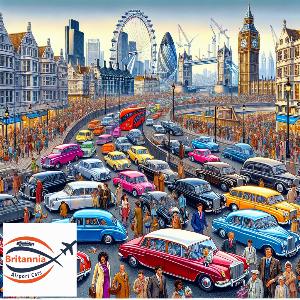Historic London: A Step Back in Time Through Iconic Landmarks
Tower of London
The Tower of London, a UNESCO World Heritage Site, is an iconic symbol of London's rich history. Established by William the Conqueror in the 11th century, it has served various purposes over the centuries, including a royal palace, prison, treasury, and even a zoo. The Tower is most famous for housing the Crown Jewels, a collection of over 23,000 gemstones that are still used in royal ceremonies. Its bloody history is filled with tales of beheadings and imprisonments, including those of Anne Boleyn and Sir Walter Raleigh. The Tower's architecture is a testament to the Norman Conquest, with the White Tower being its most recognizable structure. Today, the Tower of London offers a fascinating journey into the past, with guided tours by the Yeoman Warders, or 'Beefeaters', providing insights into its intriguing history. A visit to this historic landmark is a step back in time, offering a glimpse into the heart of London's heritage.
Westminster Abbey
Westminster Abbey, a timeless symbol of London's rich history, stands as a testament to over a thousand years of religious devotion and royal tradition. This iconic landmark, officially known as the Collegiate Church of St Peter at Westminster, has been the coronation church since 1066 and is the final resting place of seventeen monarchs. The Abbey's stunning Gothic architecture, intricate stained glass windows, and the Poets' Corner - home to memorials for legendary figures like William Shakespeare and Charles Dickens - offer a captivating journey through the annals of British history. The Abbey has also witnessed numerous royal weddings, including that of Prince William and Catherine Middleton in 2011. A visit to Westminster Abbey is not just a step back in time, but a walk through the pages of a living history book, making it an essential stop on any historical tour of London.
Buckingham Palace
Buckingham Palace, an iconic symbol of the British monarchy, is a must-visit landmark for any history enthusiast exploring London. Constructed in 1703, the palace has served as the official London residence of the UK's sovereigns since 1837. Its 775 rooms, including 19 State rooms, 52 Royal and guest bedrooms, and 78 bathrooms, are a testament to its grandeur. The palace's façade, with its famous balcony where the royal family greets the public, is a sight to behold. The Changing of the Guard, a ceremonial spectacle of British pageantry, is another highlight. The palace's extensive gardens, the largest private gardens in London, are a tranquil oasis in the heart of the city. A visit to Buckingham Palace is a step back in time, offering a glimpse into the lives of the royals and the history of the British monarchy.
British Museum
The British Museum, located in the heart of London, is a treasure trove of world history and culture. Established in 1753, it is one of the oldest and most prestigious museums in the world. Housing a vast collection of over eight million works, it offers a fascinating journey through two million years of human history. The museum's iconic exhibits include the Rosetta Stone, the Elgin Marbles, and the Egyptian mummies, each telling a unique story of civilizations past. The British Museum is not just a landmark, but a testament to human creativity, ingenuity, and endurance. Its grand architecture, with the Great Court and the Reading Room, is a sight to behold. A visit to this historic institution is a step back in time, offering a deeper understanding of the world we live in today. The British Museum is a must-visit for anyone exploring historic London.
St. Paul's Cathedral
St. Paul's Cathedral, an iconic landmark in the heart of London, is a testament to the city's rich history and architectural grandeur. Constructed in the late 17th century, it stands as a masterpiece of Britain's most renowned architect, Sir Christopher Wren. The cathedral's awe-inspiring dome, one of the largest in the world, dominates London's skyline, symbolizing the city's resilience and strength. Inside, the cathedral houses intricate mosaics, monumental sculptures, and the Whispering Gallery, known for its unique acoustics. St. Paul's Cathedral is not just a place of worship, but also a site of national significance. It has witnessed royal weddings, funerals of eminent personalities, and jubilee celebrations. A visit to this historic edifice offers a fascinating journey through time, revealing layers of London's past and its enduring spirit. St. Paul's Cathedral, with its timeless beauty and historical significance, is a must-visit for anyone seeking to explore London's rich heritage.
The Shard
The Shard, an iconic landmark in historic London, stands as a testament to the city's blend of ancient and modern architecture. Towering over the city at 1,016 feet, it is the tallest building in Western Europe. The Shard's 95 stories house a mix of offices, restaurants, a hotel, and a viewing gallery, offering panoramic views of the city. Its design, inspired by the railway lines next to the site, is a work of the renowned Italian architect Renzo Piano. Despite its modern design, The Shard is deeply rooted in London's history. It is located in the London Bridge Quarter, an area steeped in history dating back to Roman times. The Shard, with its striking presence, adds a contemporary edge to London's historic skyline, symbolizing the city's evolution over centuries. It is a must-visit for anyone looking to step back in time through London's iconic landmarks.
Trafalgar Square
Trafalgar Square, a historic landmark in the heart of London, is a testament to the city's rich past. Named in honor of the Battle of Trafalgar, a significant British naval victory in the Napoleonic Wars, the square has been a central meeting point since the 13th century. Dominated by Nelson's Column, a towering monument dedicated to Admiral Horatio Nelson who died in the battle, the square is a symbol of national pride. Flanked by the National Gallery and the St. Martin-in-the-Fields church, Trafalgar Square is not just a hub of history, but also of culture and art. The square's iconic fountains and bronze lions add to its grandeur, making it a must-visit for anyone stepping back in time through London's iconic landmarks. Whether it's for a peaceful stroll, a rendezvous point, or a deep dive into history, Trafalgar Square stands as a timeless beacon in the heart of historic London.
London Eye
The London Eye, an iconic landmark of historic London, offers a breathtaking perspective of the city's timeless beauty. Erected in 2000, this colossal Ferris wheel stands at a staggering 443 feet, making it one of the tallest structures in London. Despite its relatively recent construction, the London Eye has quickly become an integral part of London's historic skyline, offering panoramic views of the city's ancient and modern landmarks. Each rotation, a slow, graceful 30-minute journey, provides a unique vantage point to appreciate London's rich history. From the Houses of Parliament to St. Paul's Cathedral, the view from the Eye encapsulates centuries of architectural grandeur. The London Eye is more than just a tourist attraction; it's a testament to London's enduring charm, a fusion of the old and the new. It's a step back in time, offering a bird's eye view of the city's historic evolution, making it a must-visit for any history enthusiast.
Big Ben and the Houses of Parliament
Big Ben and the Houses of Parliament are two of the most iconic landmarks in historic London. Big Ben, the nickname for the Great Bell of the clock at the north end of the Palace of Westminster, has been keeping time since 1859. Its chimes have become a symbol of the city, resonating through the air with a sense of grandeur and tradition. Adjacent to Big Ben, the Houses of Parliament, also known as the Palace of Westminster, stand as a testament to the city's rich political history. This Gothic Revival masterpiece, with its ornate detailing and imposing structure, has been the meeting place for the two houses of the Parliament of the United Kingdom since the 13th century. A visit to these landmarks is a step back in time, offering a glimpse into London's past while standing firmly in its present.
The Globe Theatre
The Globe Theatre, an iconic landmark in historic London, offers a fascinating step back in time. Originally built in 1599 by Shakespeare's playing company, the theatre was the venue where many of the Bard's greatest plays were first performed. Although the original structure was destroyed by fire in 1613, a faithful reconstruction now stands just a few hundred yards from the original site. This modern Globe Theatre, opened to the public in 1997, is a testament to London's rich theatrical history. Visitors can experience the unique atmosphere of an open-air, circular playhouse, just as audiences did in Shakespeare's time. The theatre also houses an exhibition exploring the life of Shakespeare, the London where he lived, and the theatre for which he wrote. A visit to the Globe Theatre is a must for any history or theatre enthusiast, offering a unique glimpse into the world of Elizabethan drama.
Our Latest Blog Posts

The Thames at Twilight: Evening Strolls and Riverside Views
Blog about The Thames at Twilight: Evening Strolls and Riverside Views
Read More
Piccadilly to Portobello: A Shoppers Guide to London Markets
Blog about Piccadilly to Portobello: A Shoppers Guide to London Markets
Read More
In the Footsteps of Sherlock: A Detectives Tour of London
Blog about In the Footsteps of Sherlock: A Detectives Tour of London
Read More
London by Bike: Exploring the Citys Cycle-Friendly Routes
Blog about London by Bike: Exploring the Citys Cycle-Friendly Routes
Read More
Historical Mysteries: Secret Spots and Unsolved Tales in London
Blog about Historical Mysteries: Secret Spots and Unsolved Tales in London
Read More
The West End Extravaganza: A Guide to Londons Theatre Scene
Blog about The West End Extravaganza: A Guide to Londons Theatre Scene
Read More
Londons LGBTQ+ Scene: Pride, Bars, and Inclusive Spaces
Blog about Londons LGBTQ+ Scene: Pride, Bars, and Inclusive Spaces
Read More
Navigating London Airport Minicabs: A Comprehensive Guide for First-Time Travelers
Blog about Navigating London Airport Transfers: A Comprehensive Guide for First-Time Travelers
Read More
Londons Multicultural Melting Pot: Ethnic Enclaves and Festivals
Blog about Londons Multicultural Melting Pot: Ethnic Enclaves and Festivals
Read More
Urban Nature: Wildlife Encounters in Londons Parks
Blog about Urban Nature: Wildlife Encounters in Londons Parks
Read More
Sunset Silhouettes: Romantic Evening Spots in London
Blog about Sunset Silhouettes: Romantic Evening Spots in London
Read More
Londons Sporting Scene: From Football Matches to Wimbledon
Blog about Londons Sporting Scene: From Football Matches to Wimbledon
Read More
Artistic Flair: Londons Trendiest Art Galleries and Studios
Blog about Artistic Flair: Londons Trendiest Art Galleries and Studios
Read More
The Perfect Weekend in London: A 48-Hour Itinerary
Blog about The Perfect Weekend in London: A 48-Hour Itinerary
Read More
Parks and Picnics: Londons Green Spaces to Relax and Recharge
Blog about Parks and Picnics: Londons Green Spaces to Relax and Recharge
Read MoreBlog Posts
- Londons Festive Markets: Holiday Shopping Extravaganza
- Fitness Fanatics: Running and Cycling Routes in London
- A Romantic Getaway: Love-Struck Escapes in London
- London for Thrill-Seekers: Adrenaline-Pumping Activities
- Secret Gardens: Hidden Green Oases in the Heart of London
- Instagram-Worthy London: The Most Photogenic Spots
- Family Bonding: Fun Activities for All Ages in London
- Waterside Walks: Scenic Strolls Along Londons Canals
- Londons LGBTQ+ Scene: Pride, Bars, and Inclusive Spaces
- STUDENT TRANSPORT Description
- Shakespearean London: Exploring the Bards Legacy in the City
- Chasing Shadows: Londons Most Haunted Places
- Londons Literary Legends: Homes and Hangouts of Famous Write
- Londons Haunted History: Spooky Sites and Ghostly Tales
- Summer in the City: Outdoor Events and Festivals in London
- Parks and Picnics: Londons Green Spaces to Relax and Recharg

